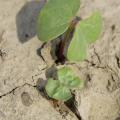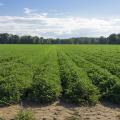Crop Report from 2016
STARKVILLE, Miss. -- Crop decisions made in January based on markets and profit potential may be cloudy memories for growers waiting on fields to dry out enough to allow spring plantings.
Brian Williams, an agricultural economist with the Mississippi State University Extension Service, said growers have purchased seed and locked in their planting intentions, unless rains prevent timely plantings. Few changes will be based on the market’s response to the U.S. Department of Agriculture Prospective Plantings Report released March 31.
STARKVILLE, Miss. -- Winter conditions did not significantly affect wheat development in Mississippi, but acreage of the state’s only cold-season row crop is expected to be much lower than normal due to poor planting conditions last fall.
Erick Larson, corn and wheat specialist with the Mississippi State University Extension Service, said 90,000 acres of wheat were planted last fall. The normal acreage is usually around 200,000 acres. Producers planted 230,000 acres in 2014 and 150,000 acres in 2013.
STARKVILLE, Miss. -- Frequent spring rains and standing water have kept farmers out of their fields, reducing expectations for the state’s corn crop.
Erick Larson, grain crops specialist with the Mississippi State University Extension Service, said growers are struggling to plant the amount of corn they intended. The U.S. Department of Agriculture predicted Mississippi’s corn acreage would be 800,000, up 57 percent from last year’s 510,000 acres.
STARKVILLE, Miss. -- Mississippi poultry and egg companies are poised for expansions to fill the national gaps caused by the 2015 bird flu outbreaks in other states.
Tom Tabler, poultry specialist with the Mississippi State University Extension Service, said companies are looking for more broiler growers or additional barns on existing farms.
CRYSTAL SPRINGS, Miss. -- Record-breaking rain and cloudy skies this spring increased disease problems in most of Mississippi’s strawberry crop and decreased the sweetness of the popular berries.
“It’s been one of the wettest Marches in years statewide, and the wettest March in history for Jackson,” said Bill Evans, a horticulture researcher with Mississippi State University. “When strawberry plants get wet and stay wet, they get diseased.”
STARKVILLE, Miss. -- A cool, wet spring delayed growth of several summer grasses, but not the weeds that compete for space in fields and pastures across Mississippi.
Rocky Lemus, forage specialist with the Mississippi State University Extension Service, said the state has about 903,000 acres of bahiagrass and 770,000 acres of bermudagrass.
STARKVILLE, Miss. -- Spring rains created their typical obstacle course for Mississippi soybean growers trying to get fields planted as soon as possible.
“Growers are covering a lot of ground this week (May 8-13) trying to plant before the next rain,” said Trent Irby, soybean specialist with the Mississippi State University Extension Service. “Frequent rains have made the planting season a challenge. Growers are planting all they can between these rains. Even with these challenges, we are only slightly behind where we were last year in terms of planting progress.”
STARKVILLE, Miss. -- Cotton producers made rapid planting progress in mid-May on increased acreage, hoping the recent trend of high yields will continue in a year of low prices for all crops.
Darrin Dodds, cotton specialist with the Mississippi State University Extension Service, said dry weather during the second week of May allowed farmers to kick planting into high gear.
STARKVILLE, Miss. -- An abundance of cool-season grasses and legumes means plenty of forage for Mississippi dairy cows, but increased nationwide milk production is driving down profits for the state’s producers.
Producers are receiving $12.75 per hundredweight, or about $1.10 per gallon of milk. A year ago, they were being paid just under $20 per hundredweight.
Brian Williams, an agricultural economist with the Mississippi State University Extension Service, said the sharp decrease is driven by supply.
POPLARVILLE, Miss. -- The first half of June is usually a busy time for blueberry growers in Mississippi, and this year is no different, as recent dry conditions have expedited the crop’s harvest.
A few scattered small-market “U-Picks” can be found in north and central portions of the state, but most of the commercial activity is happening south of Interstate 20, where rain has been in short supply lately. Wayne County boasts the highest blueberry production in the state.
STARKVILLE, Miss. -- It was clear by early June that spring’s wet, cool weather caused few issues for Mississippi’s rice crop, as growers got it planted on time and the emerged crop looks good overall.
The U.S. Department of Agriculture estimated that as of June 5, the crop was 99 percent planted and 97 percent emerged. Of that acreage, 78 percent was in good or excellent condition, and 20 percent was in fair condition.
BILOXI, Miss. -- Selling directly to the public takes longer, but it allows fishermen to make some profit from a shrimp season that has been below average so far this year in Mississippi.
Dave Burrage, commercial and recreational fisheries specialist with the Mississippi State University Extension Service, said shrimp landed in Mississippi have been small through mid-June.
STARKVILLE, Miss. -- Watermelons need ample water to grow, but rains also contribute to disease pressure, and cloudy skies reduce the melons’ sweet taste.
David Nagel, a horticulturist with the Mississippi State University Extension Service, said dry conditions hurt the size of melons that were not irrigated, but their flavor should be excellent.
RAYMOND, Miss. -- An increase in housing starts in 2015 strengthened Mississippi’s timber industry, and stronger demand for sawtimber products used in construction are helping give the industry a boost this year.
James Henderson, an associate professor of forestry with the Mississippi State University Extension Service, said timber ended the year with a total estimated harvest value of almost $1.67 billion.
STONEVILLE, Miss. -- As demand for catfish remains high, the only components of its production trending down this year in Mississippi are pond acreage and the price of feed.
Producers are receiving an average of $1.12 to $1.21 per pound of catfish and paying less than $380 for a ton of feed. To Jimmy Avery, Extension aquaculture professor at the Mississippi State University Delta Research and Extension Center in Stoneville, those data are good news for the bottom line.
STARKVILLE, Miss. -- Reduced acreage, average yields and low prices have added up to another tough year for Mississippi wheat farmers.
The state’s wheat appears to be on track for a third consecutive year in which the value of production was cut in half from the previous year.
Mississippi State University Extension Service agricultural economist Brian Williams said wheat production values were $154.5 million in 2013, $71.7 million in 2014 and $31.5 million in 2015.
STARKVILLE, Miss. -- Favorable weather and a steady consumer appetite for local produce are keeping Mississippi’s truck crop industry strong.
The state now has more than 80 farmers markets, compared to 52 in 2010. These markets make up the main avenue through which truck crop growers sell their goods, but local produce can be found with more frequency on grocery store shelves during the growing season. This trend reflects the shift in consumer preference.
STARKVILLE, Miss. -- July rains hold a special place in soybean growers’ hearts – and in their pocketbooks.
“July is typically a very hot, dry month, but it’s also one when soybeans still need water to grow and fill out pods,” said Trent Irby, soybean specialist with the Mississippi State University Extension Service. “There have been some exceptions, but most growers have been lucky to get some showers to help their crops along.
PELAHATCHIE, Miss. -- Rankin County forage producer Jeff Adams anticipates an average hay harvest this year, but he has sprayed twice for fall armyworms in just three weeks.
“I’ve used two different sprays that are supposed to give you a 20-day residual between applications,” he said. “Neither one got me through more than seven.”
RAYMOND, Miss. -- With few problems this year, Mississippi’s peanut growers should see a good crop.
“Overall, peanuts are doing very well,” said Jason Sarver, Mississippi State University Extension Service peanut specialist. “Peanuts in south Mississippi received consistent rain throughout the season. We were really dry for a while across northeast Mississippi and the Delta. But between days 70 and 80, we started catching some rains across both regions that helped make a nice crop.”



















